Introduction to the Recipe
Southern cooking is rich with tradition, symbolism, and comfort—and nothing reflects that better than a classic Southern New Year’s Day Dinner Skillet. Rooted in folklore and passed down through generations, this one-pan meal blends the iconic flavors of collard greens, black-eyed peas, bacon, and tender chicken to create a richly satisfying dish believed to bring prosperity, luck, and good fortune for the coming year. While traditionally served on New Year’s Day, this bold, hearty skillet is delicious enough to enjoy any time you want big Southern flavor in a simple, nourishing meal.
Collard greens represent wealth and prosperity because of their resemblance to folded money. Black-eyed peas symbolize good luck and abundance. Bacon adds smoky depth, while onions, garlic, and red pepper flakes build layers of savory Southern comfort. Whether you’re celebrating the holiday or simply craving something soul-warming, this recipe celebrates all the aromas and textures that make Southern cuisine unforgettable. For deeper insight into Southern New Year food traditions, you may enjoy learning from this resource: https://www.southernliving.com/culture/traditions/southern-new-years-food-traditions. And if you’d like more techniques for preparing collard greens in authentic Southern style, this guide is helpful: https://www.seriouseats.com/how-to-cook-collard-greens.
This one-pan dish is especially convenient because it’s wholesome, filling, and easy to personalize. Served over brown rice and topped with cheddar cheese and green onions, it becomes a full meal that balances smoky, savory, tangy, and earthy flavors beautifully. The entire recipe cooks quickly, making it ideal for home cooks who want something comforting without spending all day in the kitchen. Whether you’re honoring a cherished tradition or exploring Southern flavors for the first time, this southern new year’s day dinner skillet offers an irresistible blend of meaning, nutrition, and flavor in every bite.
Dinner Skillet Recipe — Ingredients and Instructions
Print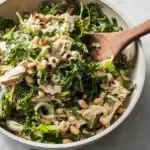
Southern New Year’s Day Dinner Skillet (Easy One-Pan Tradition)
Description
This Southern New Year’s Day Dinner Skillet brings bacon, greens, and black-eyed peas together for good luck and delicious comfort.
Ingredients
Main Skillet
- 5 slices bacon
- 1 small onion, chopped
- 2 cloves garlic, minced
- 1/4 teaspoon red pepper flakes
- 1 bunch collard greens, stems removed, rolled tightly, thinly sliced
- 1/4 teaspoon salt
- 1/4 teaspoon black pepper
- 1/4 cup low-sodium chicken broth
- 1 (14.5-oz) can black-eyed peas, rinsed and drained
- 1 1/2 cups cooked chicken breast, chopped
- 1 tablespoon white wine vinegar
For Serving
- Cooked brown rice
- Shredded cheddar cheese
- Sliced green onions
Instructions
- Cook the bacon: In a large skillet, cook bacon over medium heat until crispy. Remove and crumble; leave 1–2 tablespoons of drippings in the pan.
- Sauté aromatics: Add onion and cook until soft, 3–4 minutes. Add garlic and red pepper flakes; cook 30 seconds.
- Cook the collard greens: Add collards, salt, and pepper. Toss to coat with aromatics. Pour in chicken broth and cook until greens soften, about 10 minutes.
- Build the skillet: Add black-eyed peas and cooked chicken. Stir well.
- Season: Add white wine vinegar and crumble in the cooked bacon.
- Serve: Spoon over brown rice and top with cheddar cheese and sliced green onions.
Notes
You can substitute kale or mustard greens for collard greens.
Smoked chicken or turkey works beautifully for richer flavor.
Add more broth if you prefer a saucier skillet meal.
Vinegar brightens the dish—don’t skip it.
Advanced Techniques
Mastering the Texture of Collard Greens
Collard greens can easily become too tough or too soft depending on cooking technique. For the perfect texture in your southern new year’s day dinner skillet, make sure to slice the greens thinly after rolling them tightly into a chiffonade. This increases tenderness and ensures they cook evenly without needing long simmering times. Using broth instead of water enhances richness, and covering the skillet for a few minutes allows the greens to steam gently. Avoid overcooking them, as they can lose their structure and turn mushy. The goal is tender, silky greens that still hold their vibrant color.
Enhancing Smoky Southern Flavor
Traditional Southern dishes often rely on smoked meats like ham hocks, turkey legs, or bacon to build flavor. For an elevated version of this skillet, consider layering smoky elements. Start with hardwood-smoked bacon and reserve the drippings. Add a dash of smoked paprika or a splash of liquid smoke for depth without overpowering the dish. You can also use smoked chicken instead of plain cooked chicken to reinforce the flavor profile. Each smoky layer contributes richness and authenticity while keeping the dish balanced and deeply aromatic.
Building Flavor in the Aromatic Base
The aromatic base is the backbone of this recipe. Slowly sweating onions in bacon drippings enhances sweetness and sets the stage for a deeply flavorful dish. Adding garlic and red pepper flakes at the right moment ensures they bloom in the oil without burning. If you want additional complexity, incorporate a small amount of celery or bell pepper for a more traditional Southern “holy trinity” base. Cooking aromatics slowly over medium heat allows their natural sugars to caramelize slightly, enriching the overall depth of flavor in the skillet.
Achieving Perfect Balance with Acidity
Acid is essential for cutting through the richness of bacon and greens. White wine vinegar provides brightness and prevents the dish from tasting flat, but you can elevate this further by adding acidity in stages. Stir in the vinegar at the end, but consider finishing with a squeeze of lemon or a splash of apple cider vinegar for a slightly sweeter tang. Acid also helps soften greens and enhances the earthy flavors of black-eyed peas. The right level of acidity brings harmony, making every bite vibrant and well-balanced.
Creating a One-Pan Meal With Ideal Moisture
A great skillet meal requires the perfect moisture balance—not too dry, not too soupy. Collard greens release some liquid during cooking, but the broth ensures they soften properly. If you prefer a thicker skillet, cook uncovered to reduce moisture. For a juicier version, add more broth during the cooking process. Stirring in a spoonful of bacon drippings also enriches the base. Proper moisture ensures all ingredients meld together into a cohesive dish without drowning out the texture of the rice or toppings.
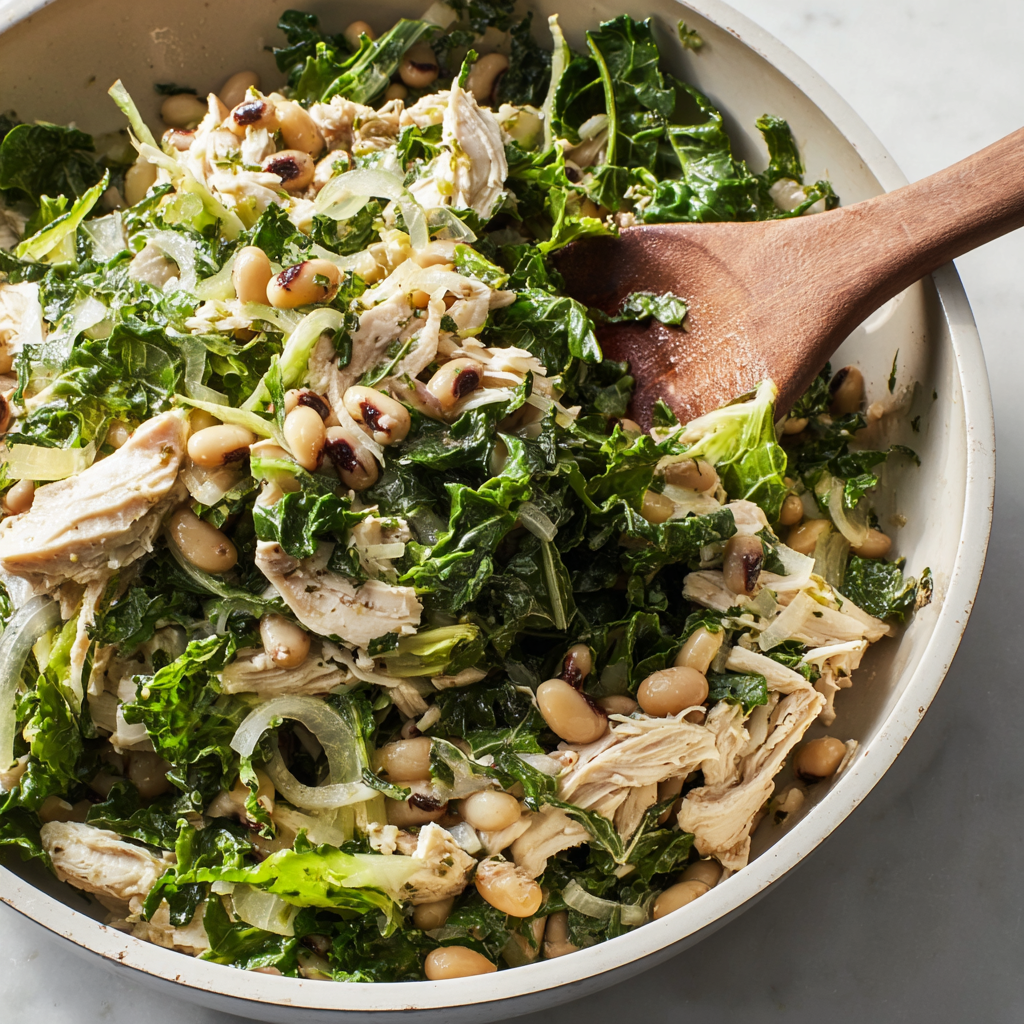
Storage, Shelf Life, and Maintenance Tips
Storing the Skillet in the Refrigerator
The southern new year’s day dinner skillet stores exceptionally well. Once cooled, place leftovers in an airtight container and refrigerate for 3–4 days. Keep rice and toppings separate to preserve texture. Collard greens and black-eyed peas often taste even better the next day because the flavors deepen. When reheating, use the stovetop over medium heat with a splash of broth to maintain moisture. Avoid microwaving cheese toppings directly, as they may toughen. Add fresh green onions after reheating to preserve brightness.
Freezing for Long-Term Convenience
This skillet freezes beautifully, making it a great meal prep option. Cool completely, then pack into freezer-safe containers. Freeze for up to 3 months. To maintain texture, freeze rice separately or cook fresh when reheating. Thaw overnight in the refrigerator, then warm on the stove with additional broth if needed. The greens and black-eyed peas hold up well in the freezer, preserving flavor without becoming mushy. Adding fresh toppings after reheating restores the dish’s crispness and freshness.
Reheating Without Losing Texture
To prevent sogginess or dryness, reheat slowly on the stovetop. Add a tablespoon of broth or water before heating to maintain moisture. Stir occasionally to ensure even warming. If reheating in the microwave, use 50% power and heat in 1-minute increments to avoid overheating. Toppings like cheddar cheese should be added afterward to prevent separation. Collard greens reheat better than many leafy greens, so texture remains pleasant when warmed correctly.
Keeping Ingredients Fresh for Weekly Meal Prep
If preparing components ahead of time, store each ingredient separately. Cook bacon up to three days in advance and refrigerate. Wash and slice collard greens, but store them in paper towels inside a sealed bag to prevent wilting. Cooked chicken stays fresh for 3–4 days refrigerated. Black-eyed peas should be rinsed and stored in airtight containers. Preparing ingredients ahead ensures assembling the skillet takes only minutes, making it ideal for busy schedules.
Reviving Flavor After Storage
Over time, refrigerated skillet meals may lose a bit of vibrancy. Revive flavors by adding a splash of vinegar, fresh herbs, or a pinch of salt during reheating. A little extra black pepper restores heat, while a fresh sprinkle of cheddar and green onions adds brightness and contrast. Reheating with a small spoonful of bacon drippings also enhances richness. Adjust seasoning gently, tasting as you go, to maintain the dish’s original balance.
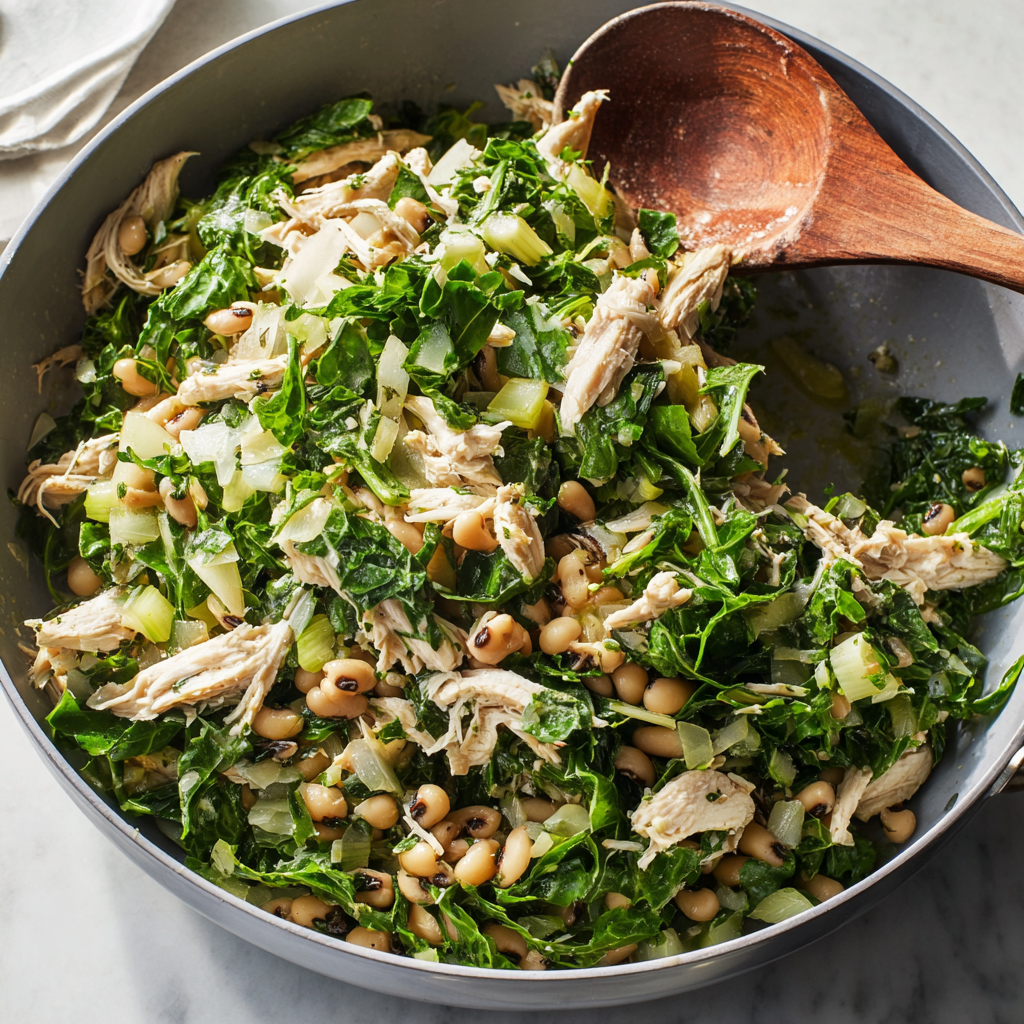
Dietary Adaptations and Substitutions
Making It Vegetarian
To make a vegetarian version of the southern new year’s day dinner skillet, replace bacon with smoked paprika or vegetarian bacon alternatives. Use vegetable broth instead of chicken broth. Smoked salt adds richness without meat. For protein, add white beans, chickpeas, or tofu cubes. The heartiness of collard greens and black-eyed peas ensures the dish stays deeply satisfying even without meat.
Gluten-Free Adjustments
This recipe is naturally gluten-free when served over gluten-free grains like rice or quinoa. Ensure broth and cheese are certified gluten-free. For additional texture, serve over roasted sweet potatoes instead of rice. Most Southern ingredients used here—collards, chicken, beans—contain no gluten, making this an easy meal for gluten-free diets.
Low-Sodium Version
To reduce sodium, use no-salt-added black-eyed peas and low-sodium broth. Skip added salt and rely on garlic, onion, vinegar, and pepper for flavor. Bacon contributes saltiness, so consider using reduced-sodium bacon or decreasing the amount. Increasing herbs or adding lemon juice boosts flavor without added salt.
Dairy-Free Adaptation
The skillet itself is dairy-free; simply omit cheese when serving. For creaminess, top with avocado slices or a drizzle of olive oil. If you want a melted topping alternative, use dairy-free cheddar shreds. Ensure bacon and broth are dairy-free (most are).
Lower-Carb Serving Options
Instead of rice, serve the skillet over cauliflower rice or sautéed cabbage. Reduce beans slightly and increase greens for a low-carb balance. The dish’s smoky flavor still shines with these alternatives, offering a lighter version suitable for keto or low-carb diets.
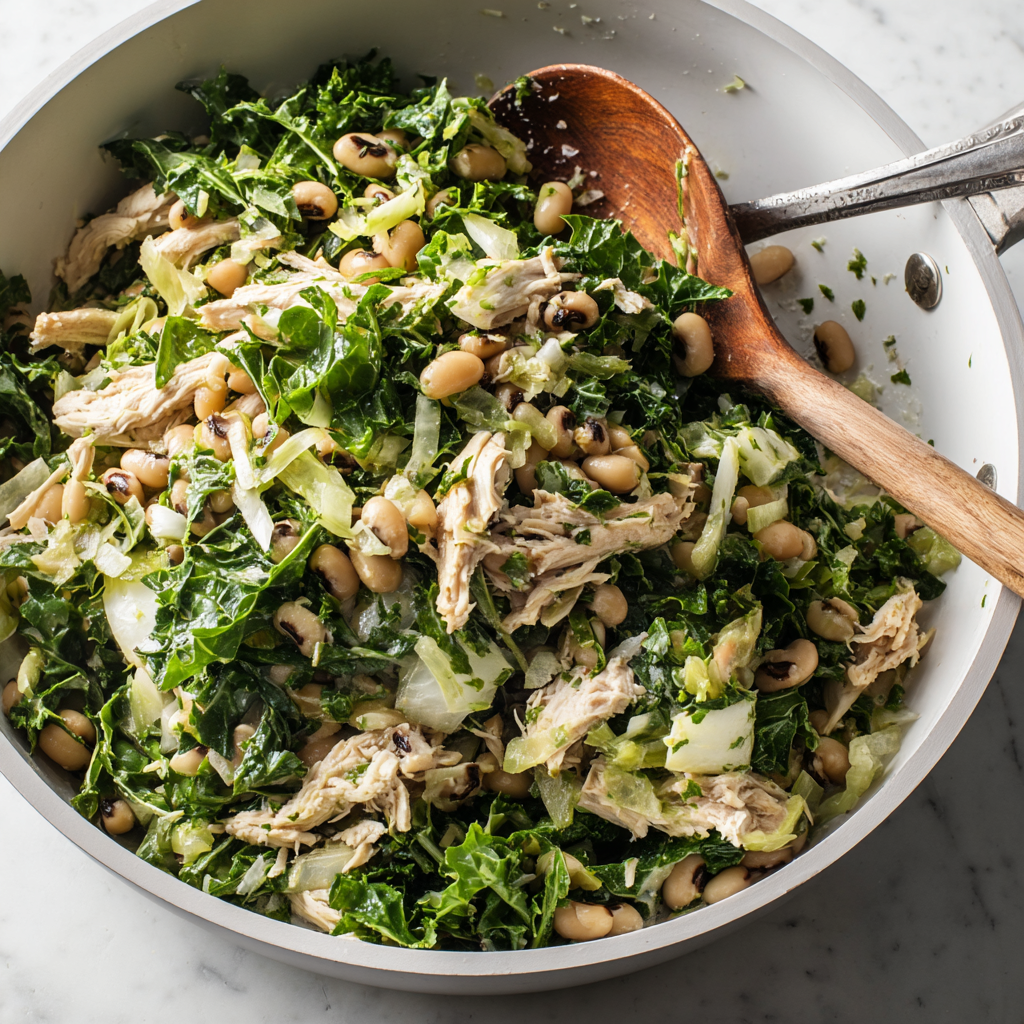
FAQs About the Recipe
Why Are Collard Greens Used for New Year’s?
Collard greens symbolize money and prosperity due to their resemblance to folded bills. In Southern tradition, eating greens on New Year’s Day is believed to bring wealth in the coming year. Beyond symbolism, collards are hearty, nutritious, and flavorful—making them perfect for this savory skillet. Their robust texture stands up well to heat and pairs beautifully with bacon, peas, and chicken.
Can I Use Other Greens Instead of Collards?
Yes, kale, mustard greens, or Swiss chard work as substitutes. However, each green behaves differently. Kale stays firmer, mustard greens add peppery heat, and chard cooks down quickly. Adjust cooking time accordingly to prevent over-softening. Collards remain the most traditional choice for New Year’s dishes, but substitutions still produce a delicious skillet.
Can I Make This Dish Without Bacon?
Absolutely. Replace bacon with a tablespoon of olive oil and a pinch of smoked paprika for depth. For a richer flavor, sauté onions in butter or vegan butter. You can also add smoked turkey or ham alternatives. The skillet remains hearty thanks to the chicken and black-eyed peas.
How Do I Keep the Greens From Becoming Bitter?
Choose fresh, deep-green collards without yellowing. Remove tough stems and slice thinly. Cooking greens with onions, garlic, and bacon reduces bitterness. A splash of vinegar at the end brightens the flavor and mellows any remaining bitterness. Overcooking can intensify bitterness, so keep an eye on timing.
Can I Add More Vegetables to the Skillet?
Yes! Bell peppers, celery, carrots, or diced tomatoes make excellent additions. Add firmer vegetables earlier so they soften properly. Extra vegetables enhance nutrition and flavor without detracting from the traditional elements. Just maintain balance so no single ingredient overwhelms the Southern character of the dish.
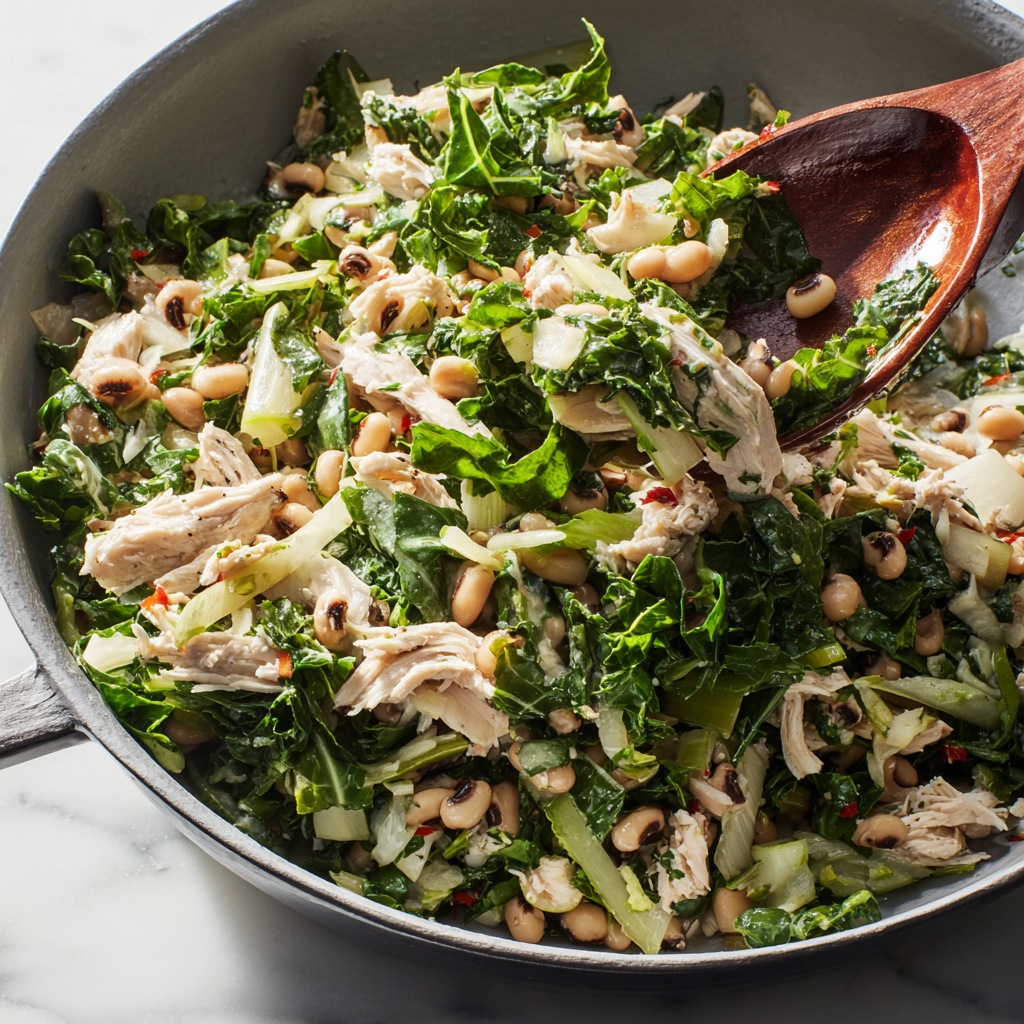
Conclusion & Final Thoughts
The southern new year’s day dinner skillet is far more than a meal—it’s a celebration of heritage, comfort, and good fortune. By combining collard greens, black-eyed peas, bacon, and chicken, you’re creating a dish steeped in tradition yet perfectly suited for modern kitchens. Its symbolism adds meaning to every bite, while its bold flavors deliver deep satisfaction year-round. With just one skillet, you can prepare a meal that feels both rustic and refined, comforting and vibrant.
What makes this dish exceptional is its balance of flavors: the smokiness of bacon, the earthy satisfaction of beans, the robust texture of collard greens, and the brightness provided by a splash of vinegar. Served over rice and topped with sharp cheddar and fresh green onions, it becomes a complete, hearty dinner that appeals to all ages. The versatility also makes it ideal for adapting to dietary needs or personal preferences, whether you’re adjusting for low sodium, adding extra vegetables, or swapping proteins.
Perhaps the most meaningful aspect of this recipe is how it brings people together. Southern New Year foods are traditionally enjoyed with family and friends, symbolizing unity and shared hope for the coming year. Even if you’re making this dish outside of the holiday, it carries a comforting warmth that feels celebratory and nourishing.
Whether you’re honoring old traditions or starting new ones, this skillet offers a delicious reminder of the flavors and stories that shape Southern cuisine. With its simple ingredients, comforting aromas, and rich cultural history, the southern new year’s day dinner skillet is a recipe worth returning to again and again.
